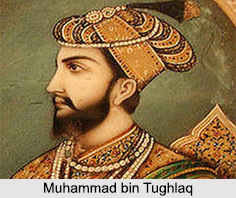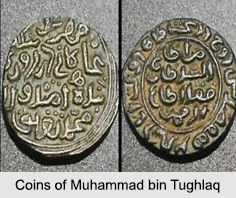 Also known by other names like Prince Fakhr Malik, Jauna Khan and Ulugh Khan, Muhammad bin Tughlaq was a prominent figure during the medieval Indian history. He was popular for his numerous policies and reforms that earned him the tag of "wise fool" among all the other Indian rulers. He succeeded his father Ghiyas- ud- din- Tughlaq in 1325, who was the founder of the Tughlaq dynasty.
Also known by other names like Prince Fakhr Malik, Jauna Khan and Ulugh Khan, Muhammad bin Tughlaq was a prominent figure during the medieval Indian history. He was popular for his numerous policies and reforms that earned him the tag of "wise fool" among all the other Indian rulers. He succeeded his father Ghiyas- ud- din- Tughlaq in 1325, who was the founder of the Tughlaq dynasty.
Muhammad bin Tughlaq ruled over the northern parts of the Indian subcontinent and the Deccan from 1325 to 1351 AD. A controversial ruler with a unique streak of intellectual creativity, Muhammad bin Tughlaq was one of the few Sultans of Delhi who received a comprehensive literary, religious and philosophical education.
Reign of Muhammad bin Tughlaq
During the reign of Muhammad bin Tughlaq, he annexed kingdoms around his Sultanate and conquered areas like Warangal or modern day Telangana, Malabar, Madurai and even to the southern tip of the Indian state of Karnataka. His rule was faced with several attacks from the Mongols and rebellions from a large, diverse population.
Some of the important administrative policies of Muhammad bin Tughlaq are discussed below elaborately:
Religious Policy of Muhammad bin Tughlaq
Muhammad bin Tughlaq believed in the absolute power of the Sultan and did not allow anyone to interfere in his administration. He made decisions regarding the matters of religious policy and did not consent the Ulema class to get in the way of his administration.
During his reign, the Ulema class enjoyed domination over administration of justice. Muhammad bin Tughlaq broke up that monopoly and appointed Qazis outside this class of people. He used to modify the decisions of Qazis whenever he found them unfair and discriminating. If a religious man was found accountable of dishonesty or revolt, he was punished like any other common person. Thus nobody was above the laws of the land.
Revenue Reforms of Muhammad bin Tughlaq
Muhammad bin Tughlaq carried out many measures for the improvement of the administration of revenue. One of his measures was preparation of a register in which income and expenditure of all the princes were recorded. All provincial governors were asked to submit the reports of income and expenditure of their concerning provinces to the centre for this purpose. Nothing advantageous came out of the scheme.
Taxation in Doab
Taxation in the Doab was increased during the initial years of the reign of the Sultan. The taxes were increased at the time when there was a famine in the Doab owing to the failures of the rain. The peasants instead of paying taxes abandoned their lands and adopted highway robbery. The tax collectors continued to collect taxes by oppression which resulted in widespread revolts. Thus this scheme of the Sultan failed severely.
Agricultural Policy of Muhammad bin Tughlaq
Muhammad bin Tughlaq had set up a separate department of agriculture and appointed a minister to look after it. The main object of the department was to increase the land under cultivation. Though the government spent an exorbitant sum of money but this experiment failed and the scheme was abandoned after 3 years. The corruption of the officer, inferior quality of land chosen for farming and lack of interest of cultivators who were assigned land under government administration were accountable for the failure of the scheme.
 Transfer of Capital by Muhammad bin Tughlaq
Transfer of Capital by Muhammad bin Tughlaq
Muhammad bin Tughlaq attempted to transfer the capital from Delhi to Devagiri which was renamed Daultabad. His motive to shift was to prevent his capital from recurring Mongol raids, to gain control over the rich fertile lands of the Deccan and ensure access to the busy ports on the Gujarat and the Coromandel Coast.
Muhammad bin Tughlaq"s decision was not fundamentally wrong if the shift was just limited to his official court. But he wanted the entire population of Delhi to shift and thus the journey from Delhi to Daultabad was a harrowing experience for the people as many died on the way. This scheme of the Sultan failed massively.
Introduction of Token Currency by Muhammad bin Tughlaq
During his reign, Muhammad bin Tughlaq introduced the system of token currency and fixed up their relative values. The remarkable feature of the coinage system was the introduction of copper and brass coins. The Sultan made these token coins legal tenders and kept their value at par with gold and silver coins. He launched the coins without taking any precaution against forgery. The market was flooded with fake coins and there was economic chaos. In this situation, the Sultan withdrew all the copper coins, which caused a huge loss to the royal treasury. This scheme of the Sultan also failed miserably.
Conquests of Muhammad bin Tughlaq
Muhammad bin Tughlaq like his father pursued the policy of annexation. Whatever territories he conquered, he annexed them to the Delhi Sultanate and, thus extended its territories to the extent which no other Sultan of Delhi had even attempted. The Sultan conquered Peshawar and Kalanor after the return of the Mongols. The fort of Nagarkot was in Kangra district in Punjab. No Muslim ruler had conquered it by then and it was in the hands of a Hindu king. Muhammad Tughlaq conquered it though he restored it back to its ruler after his acceptance of suzerainty of Delhi. His plan to conquer Khurasan and Iraq failed miserably.
His greatest achievement was in the south, where he set out to end Hindu rule. He captured Kondhana or Singharh from Nag Nayak, which was in the vicinity of Devagiri. Therefore, its conquest was necessary for the Sultan. Muhammad bin Tughlaq, thus, conquered greater part of south India and annexed it to the Delhi Sultanate. Muhammad failed to get any success in Rajasthan. He largely succeeded in carrying out his series of conquests. Of course, he failed at few places, yet his Empire was more extensive than any other Sultan of Delhi. The authority of the Sultan was acknowledged all over India, except Kashmir, Odisha, Rajasthan and a strip of Malabar Coast, and he established an effective system of administration over this vast empire.
Revolts during Muhammad bin Tughlaq"s Empire
Though Muhammad Tughlaq succeeded in extending his empire he failed to keep it intact for long. A large part of it was lost by him during the later years of his reign. There were several reasons which led to the downfall of the Tughlaq Empire. One of the major reasons is the occurrence of several revolts in Muhammad bin Tughlaq"s reign. A few of them were attempted by his ambitious nobles. But, most of them were either the outcome of his tyrannical policy or because of his failure to keep state affairs under his power. A few of the revolts succeeded and, thus, led to the disintegration of his empire. In 1327-28 A.D, Bahram Aiba alias Kishlu Khan, governor of Uch, Sindh and Multan, revolted against the Sultan. There was a revolt in Bengal in 1327-1328 A.D and several other revolts occurred in Sunam, Samana, Kara, Bidar, Gulbarga and Multan as well.
Downfall of Muhammad bin Tughlaq
As a ruler, Muhammad Tughlaq was devoted and extremely laborious. But during his 26 years of rule, he gained no success in any field of administration. All his policies of internal reform failed and each of them taxed the resources of the empire, brought misery to his subjects and ruined his reputation among them. The failure of the Sultan as an able administrator is not only because of his own weaknesses but also because of certain circumstances and non-cooperation of his subjects who were backward and prejudiced against him.
Muhammad died when campaigning in Sindh. He was succeeded by his cousin Firoz Shah Tughlaq.






































